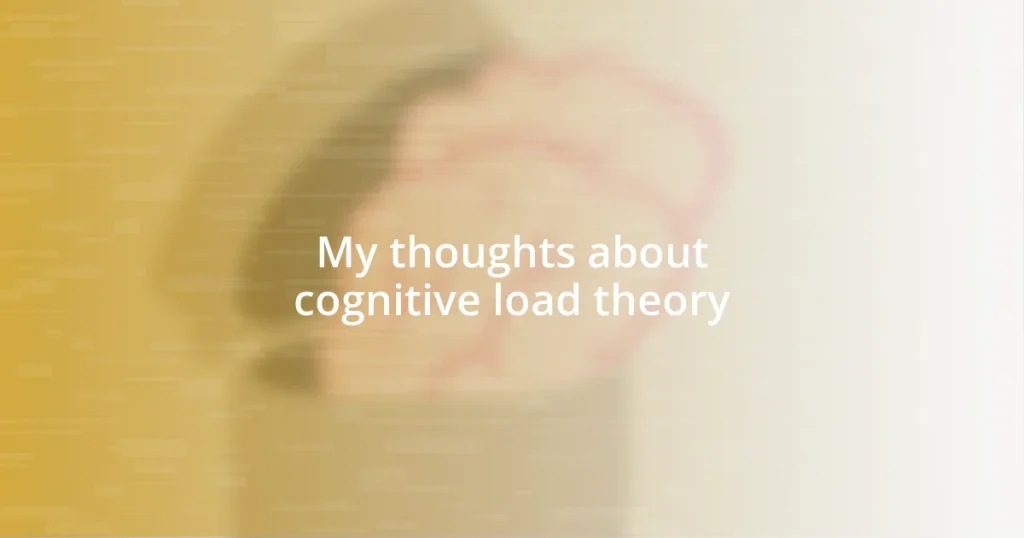Key takeaways:
- Cognitive Load Theory (CLT) explains that working memory has a limited capacity; understanding its types—intrinsic, extraneous, and germane load—can improve learning effectiveness.
- Effective techniques to manage cognitive load include chunking information, dual coding, prioritization, worked examples, and scaffolding, which enhance retention and understanding.
- Real-world examples of cognitive load highlight its impact in various settings, such as meetings, cooking, and studying, emphasizing the need for strategies to simplify complex tasks and learning materials.

Introduction to cognitive load theory
Cognitive Load Theory (CLT) is a fascinating framework that I’ve found to be incredibly useful in understanding how we process information. At its core, CLT posits that our working memory has a limited capacity, and when we overload it with too much information, learning becomes less effective. Have you ever felt overwhelmed during a lecture, struggling to keep up with the rapid-fire information? I certainly have, and it’s an eye-opener to realize that this could be due to cognitive overload.
Delving deeper into CLT, I appreciate how it categorizes different types of cognitive load: intrinsic, extraneous, and germane. Intrinsic load relates to the complexity of the content itself, while extraneous load is about how that content is presented. Germane load, on the other hand, is the cognitive energy dedicated to processing, understanding, and learning that information. Understanding these distinctions has shifted how I approach learning environments. Have you ever encountered a situation where the way material was presented made it harder to grasp? It’s an all-too-common experience that underscores the importance of instructional design.
From my perspective, CLT offers vital insights for educators and learners alike. By acknowledging the limits of working memory, we can design approaches that minimize extraneous load and enhance germane load, ultimately making learning more effective. I recall a project where I implemented CLT principles, and the difference in engagement and retention was palpable. Isn’t it compelling to think how adjusting our strategies, based on cognitive load, can lead to deeper learning experiences?

Techniques to manage cognitive load
Managing cognitive load effectively can truly transform the learning experience. One technique I’ve found immensely helpful is chunking information. By breaking down large pieces of information into smaller, digestible chunks, I can focus on one concept at a time without feeling overwhelmed. It reminds me of when I was studying for exams; instead of cramming an entire textbook in one go, I’d divide it into chapters and topics. This approach not only made studying less daunting but also improved my retention significantly.
Here are some practical techniques to manage cognitive load:
- Chunking: Divide information into smaller segments for easier absorption.
- Dual Coding: Combine verbal and visual information to enhance understanding.
- Prioritization: Focus on essential information first and save the complexity for later.
- Worked Examples: Study solved problems to understand processes before attempting similar tasks on your own.
- Scaffolding: Provide support structures that can be gradually removed as comprehension increases.
I’ve also implemented visual aids in my learning sessions, such as diagrams and mind maps. They helped me visualize complex relationships between ideas. I realized that when I could see how concepts were interlinked, it minimized that overwhelming sensation that often comes with dense text. Finding ways to intentionally interact with information not only eased my cognitive load but also made learning feel engaging and rewarding.

Real-world examples of cognitive load
Experiencing cognitive load is something I often encounter in daily life, especially during meetings where multiple topics are tossed around quickly. I remember a particularly overwhelming brainstorming session where everyone was generating ideas at breakneck speed. The room was filled with sticky notes and whiteboard scribbles, but I found myself struggling to keep pace, leading to a frustrating sense of confusion. It was clear that the cognitive load exceeded my working memory’s capacity, making it difficult to contribute meaningfully. Have you ever left a meeting feeling more drained than when you arrived? I definitely have, and it often boils down to cognitive overload.
Another example reveals itself in the world of cooking, particularly with complicated recipes. I often try to whip up elaborate dishes that have multiple steps and ingredients. When I attempt to juggle the cooking process while simultaneously reading a lengthy recipe, my cognitive load skyrockets. Somehow, I might misinterpret a crucial instruction or forget to add an ingredient, resulting in a less-than-ideal meal — and let me tell you, it’s frustrating! In contrast, when I simplify the process by preparing ingredients and following a clear, structured recipe, the experience becomes enjoyable and less taxing. It leads me to ponder: how can we make even the most complex tasks more approachable?
Lastly, I’ve noticed cognitive load acutely while studying for certifications. I often find myself poring over dense material, only to feel incapacitated when attempting to recall key concepts during practice tests. In these moments, I resort to creating concise summary notes, which help clarify complex topics. By transforming overwhelming information into approachable snippets, I can absorb and retain essential knowledge without feeling the stress of cognitive overload. It’s a transformative shift, and I would urge anyone facing similar challenges to explore ways to simplify their learning materials. What strategies have you found helpful to lighten your cognitive load?















